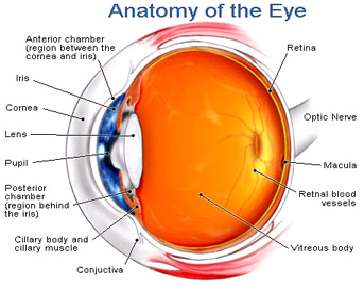 Cornea: The clear, dome shaped surface in the front of the eye. It is responsible for much of the refractive ability of the eye.
Cornea: The clear, dome shaped surface in the front of the eye. It is responsible for much of the refractive ability of the eye.
Sclera: The thick, white outer layer of the eye which serves as a protective layer.
Conjunctiva: The clear, highly vascular membrane which covers the sclera.
Iris: The iris controls the amount of light that enters the eye. The color of the iris pigment determines eye color.
Crystalline Lens: The lens is a clear structure located behind the iris that is responsible for focusing.
Vitreous: The vitreous is a gel like substance that maintains the shape of the eye.
Retina: The retina is the tissue where light is focused in the back of the eye. It is lined with special photoreceptors which translate light into signals to the brain.
Macula: The macula is a small, highly sensitive area of the retina used for detail, color, and central vision.
Optic Nerve: The optic nerve carries light signals from the retina to the brain. The brain translates the light signals into the images that we see.



